[ad_1]
You could spend countless hours planning and putting together a high-quality webinar, but unless people actually attend it, all of that work is in vain.
The key to getting people to cross the bridge from interested visitor to webinar attendee is to create a compelling webinar landing page.
This post was inspired by our 75-minute training webinar of the same name, How to Create a High-Converting Webinar Landing Page. In it, Melissa Kwan, CEO and cofounder of eWebinar, sits down with Bob Sparkins, Manager of Partnerships and Education at landing page builder Leadpages, and asks him to share his wealth of knowledge and experience on webinar landing page optimization.
During their conversation, Bob takes his 15+ years of digital marketing experience, combines it with the real-world insights he has gained from 8 years at Leadpages, and boils it all down into an easy-to-follow roadmap for creating the best webinar landing page possible with a high conversion rate you can count on.
If you want to get the full story, register for the webinar below:
Otherwise, keep reading and we’ll touch on all of the main points Bob and Melissa cover in their conversation (including webinar landing page examples that demonstrate the things they discuss).
Here is what we’ll cover:
5 things to consider before visitors even arrive on your webinar landing page
If you don’t understand who your audience is, what they want, and their mindset before visiting your landing page, you won’t be able to craft a landing page that speaks directly to their needs in a compelling way and gets them to register for your webinar.
Here are five things to consider about your audience before they arrive on your landing page:
1. Your goals versus your audience’s goals
The goals for your landing page and webinar are likely business-oriented. You may want to increase revenue or capture more leads, for example.
Your audience’s goals are very different. They have a problem, they need to find a solution, and (hopefully) they are willing to pay for it.
Everything on your landing page — text, images, everything — should reflect your understanding of their goals and your ability to solve their problem.
Achieving your own goals should be a byproduct of helping your audience achieve their goals, not the other way around.
2. Defining your audience
Although the solution you offer might appeal to a large audience, it’s very hard (if not impossible) to build a landing page that speaks compellingly to a diverse group of potential registrants.
The key is to narrow your audience to a specific niche that you can speak to with great specificity. The more specific you can be, the more appealing your message will be to whatever group of people you have chosen to target.
If you want to reach a broader audience, then you should create more webinars, each one targeting a specific subgroup of potential customers.
Although the messaging in each may be essentially the same, the specific terms you use or the ways you describe things can be adapted to appeal to each group.
Even just using different images can be enough to make different audiences feel a stronger personal connection with what you offer, as is demonstrated in the screenshot from the webinar below.
3. Visitors from ads versus organic search results
Think about where your visitors were right before they clicked to visit your landing page. Clicking on a Facebook ad, for example, where the flow of what they were doing has been interrupted, is very different from someone clicking on a search result on Google, where they were actively looking for a solution to their problem.
If you understand people’s frame of mind when they arrive on your landing page, you will be able to craft messaging that captures the visitor’s attention quickly.
This is the main purpose of a landing page. It allows you to create focused messaging leading to a specific call to action. If you were to send someone to the homepage of your website instead, for example, it would be easy for people to get distracted by everything you offer and not know what their next step should be.
4. Your reputation to visitors
Another thing to think about is the reputation you have with landing page visitors. Do they know you already? Do you have credibility or do they not know you at all?
If you are tapping into an existing audience or have a well-established reputation among those you are trying to reach, you won’t need to spend as much time on your landing page getting people over the hump of trusting you.
If anything, your responsibility is to maintain your online reputation generally. Be thoughtful about what you do on social media and on other peoples’ platforms. People are paying attention and you want to be seen as someone who delivers on everything you promise in every channel you participate in.
If you are not as well known, you will need to spend more time on your landing page gaining the trust of your audience so they see you as credible.
Be careful, however, to not speak too much about yourself. Noone wants to hear your whole life story. They only care about your experience relative to the solution you offer, so only focus on the parts of your story and experience that make that clear.
5. Understanding your offer
Your offer is the primary CTA of your webinar. It’s the next step you want people to take at the end.
This is where you need to think about the goals of your webinar. Is it to get them to book a consultation or demo, buy your product, enroll in your program, or something else?
Your goal might be to qualify leads. Someone who sits through a 30-45 minute training is going to be a higher quality lead than someone who just downloaded a white paper, for example.
Understanding your offer will help you set the tone on your landing page of what your webinar will be. It is also where you can plant the seed of what you will offer at the end. Testimonials from past clients are a good way to do this, since their successes are inferred as a result of the webinar.
The point is to always remember your end goal so that you are pointing towards that goal from the very beginning.
Webinar landing page best practices
The main purpose of a webinar landing page is to serve as a path to getting people to say “yes” to your webinar – not just a bunch of information about it.
To accomplish this goal, you must first understand the 4 emotional stages a visitor must pass through before deciding to sign up for your webinar.
Within that context, you can then answer the 4 key questions that will take them on a journey through those stages to get them to that point.
4 emotional stages of a webinar landing page visitor
Before we look at actual landing page examples, let’s first talk about the emotional stages that people go through when they visit your page, because this will inform your page’s design and structure.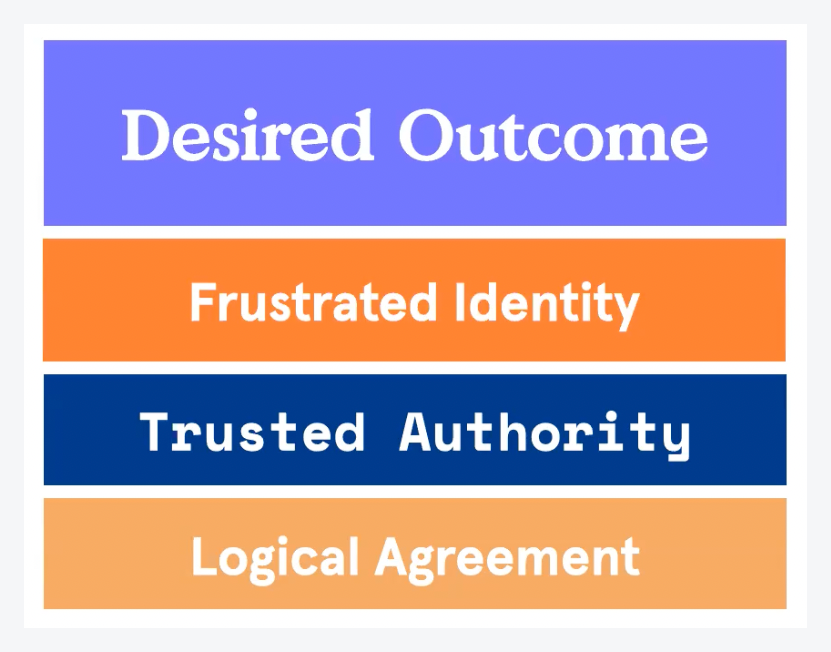 Here they are:
Here they are:
- Desired outcome: They get a strong sense your webinar can get them to their desired outcome.
- Frustrated identity: They feel you understand the frustrations they have experienced from not being able to achieve that outcome.
- Trusted authority: They believe you are the right person to help them solve their problem, because of who you are and your experience.
- Logical agreement: They can clearly see how you will be able to deliver on your promised solution using a structured, proven method.
We’ll discuss each of these stages in more detail below.
Desired outcome
The frame of mind people are in when they arrive on your landing page is they are emotionally desiring an outcome. They are seeking something out, whether that’s through a search engine, clicking on an ad, or after seeing something of yours on social media. Whatever the case, you can assume that people have a strong desire for change and are looking for a new way of handling a problem that they have.
The top part of your page needs to address this emotional sense of desire. It should not include stuff all about you. They don’t really care, to be honest. They care about themselves. They care about fixing something that is causing them frustration.
Frustrated identity
Which brings us to the second stage in their emotional journey. They need to clearly see that they’re currently in a circumstance that they find frustrating. If you can articulate that sense of frustration on your webinar registration page, you will help them identify what they are feeling and also show that you know what you’re talking about.
Trusted authority
Once they pass through the first two stages, they are going to be excited about achieving their desired outcome even though it may be a big leap from where they are now. And since you are telling them that you can help them get there, they are naturally going to want to know if you are credible and if you can actually deliver on your promise. In other words, they need to see you as a trusted authority.
Logical agreement
The last stage is you want to make sure you cover the logical aspects of the solution presented in your webinar, so that people feel not only an emotional drive to sign up, but they can clearly see how the solution you offer will take them from point A to point B to point C, their desired outcome.
People buy on emotion, but justify their purchases with logic, so be sure to lay out the basic steps or framework of your methodology.
The logical aspects of your landing page also include the logistics of attending your webinar: when is it, how long is it, how much will it cost, etc. People need to know the practical details so they can make a decision to attend.
4 key questions to answer on your webinar landing page (with examples)
Now that you understand the emotional stages a landing page visitor has to pass through before signing up for your webinar, here are the four key questions you must answer on your webinar landing page in order to make that happen:
We have included examples from actual landing pages below to show you a few different ways to approach answering each question.
1. Is this for me?
This question speaks to the first two stages of the visitor’s emotional journey: their desired outcome and frustrated identity. Answer this question at the very top of your landing page so that people immediately know they are in the right place.
Another way to ask this question would be, “Are you giving me something that I actually want?”
In the example below, the Headline, three Bullet Points, and even the Image answer this question.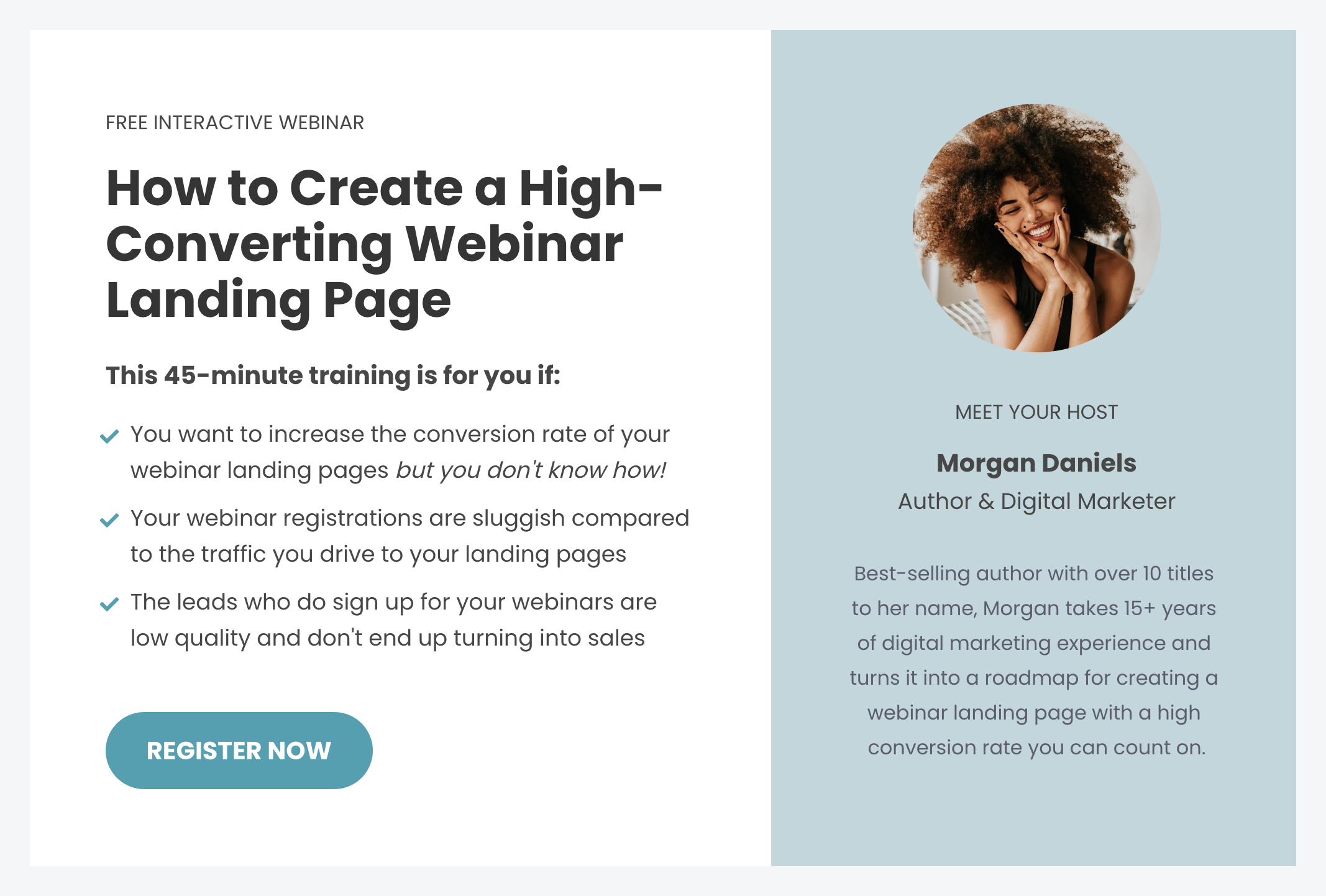
Headline
The headline on your page has to do a lot of things in a very short amount of time. You have five to ten seconds to capture people’s attention, so they stay and read more instead of bouncing away. You don’t have to get them to say yes to your webinar with your headline, but you do need to get straight to the point so they say, “Hmm, I’m intrigued”.
The critical word in the example title above is “high-converting”. The problem isn’t so much that the target audience doesn’t know how to create a webinar landing page. In fact, it’s implicit in the title that they probably already do. Rather, the desired outcome is for them to move beyond simply creating a webinar landing page to creating one that actually delivers results in the form of more webinar attendees who are also good quality leads.
If someone has been struggling with this problem, this headline should get their attention.
Bullet Points
The three bullet points beneath the headline expand on this narrative and dig into the frustrations of someone who has tried to create a high-converting webinar landing page and fallen short. The specificity of the second two points, in particular, make it clear that the person behind the webinar has likely lived this experience herself. It demonstrates an understanding of how demoralizing it can be to spend time, energy, and money creating a webinar, driving traffic to its landing page, and still having it result in a poor registration rate or sales conversion rate or both.
Image
The image above doesn’t just show who is behind the training. It also shows a person who is confident, relaxed, and happy — someone who has moved beyond frustration to success. Images are powerful when it comes to emotionally conveying a desired future state. The image could be of you, an avatar of your ideal client, or something else that conveys this sense.
2. Who’s behind this training?
This question speaks to who you are and your credibility to solve the particular problem that your webinar claims to solve.
In the example above, the Headshot and Bio of the host answer this question. You’ll notice the bio focuses on the host’s proven track record; she is a bestselling author and has 15+ years of digital marketing experience.
Be careful not to do too much horn tooting in the header section of your landing page. If it is not done well or done in excess, it can be a real turn off.
Often, it is better to demonstrate your credibility and that you know what you’re doing lower down on your landing page. This can be done in an “About me” section, yes, but sometimes testimonials are more effective because it is people tooting your horn for you.
Here is an example of that: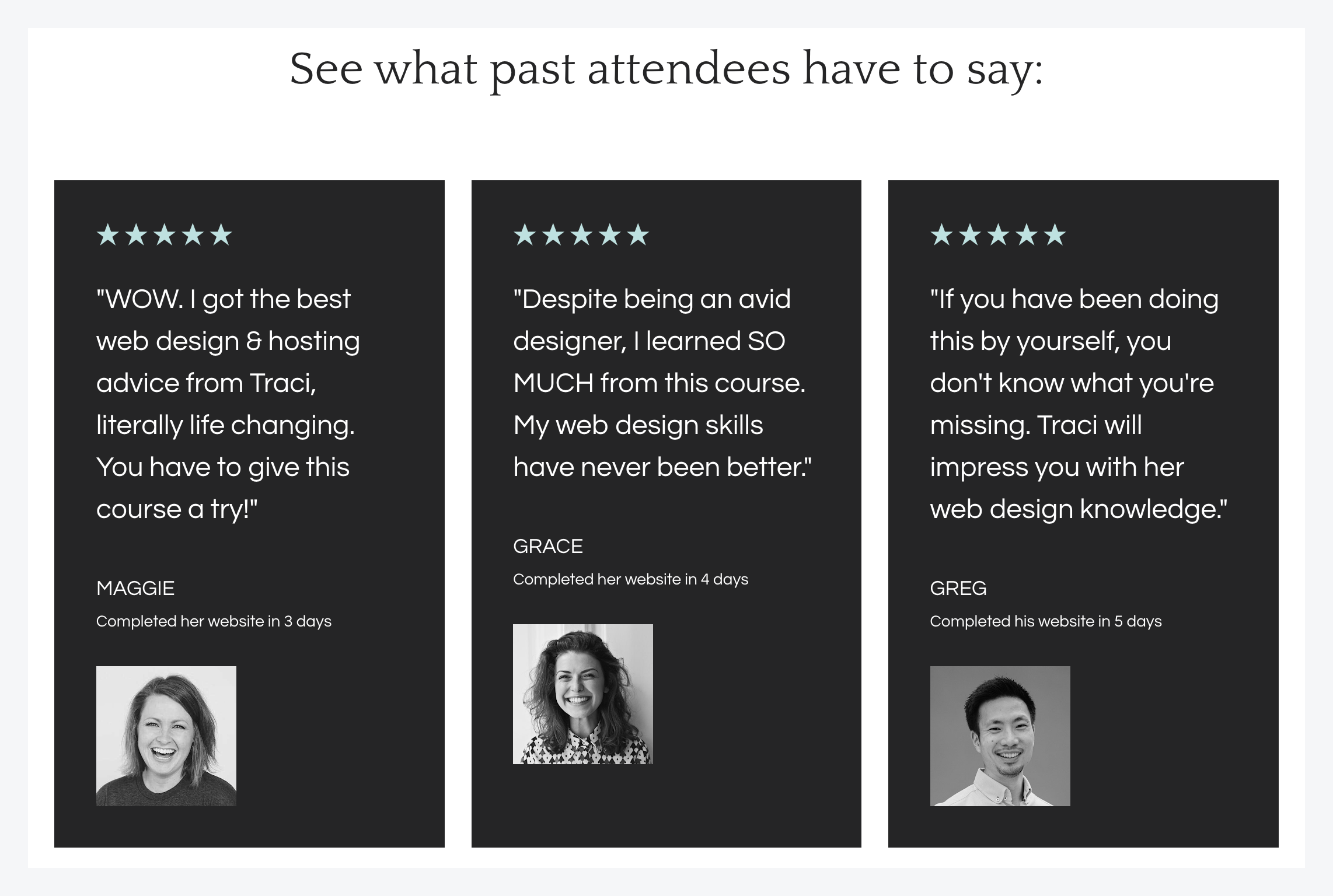 Another great way to gain trust quickly is to include a short 1-minute video invitation to your webinar on your landing page. It is a personal way of introducing yourself that gives people a chance to get a sense of who you are and what you offer.
Another great way to gain trust quickly is to include a short 1-minute video invitation to your webinar on your landing page. It is a personal way of introducing yourself that gives people a chance to get a sense of who you are and what you offer.
One more option, shown in the example below, is to tell the story of how you struggled with and learned to overcome the problem you now solve.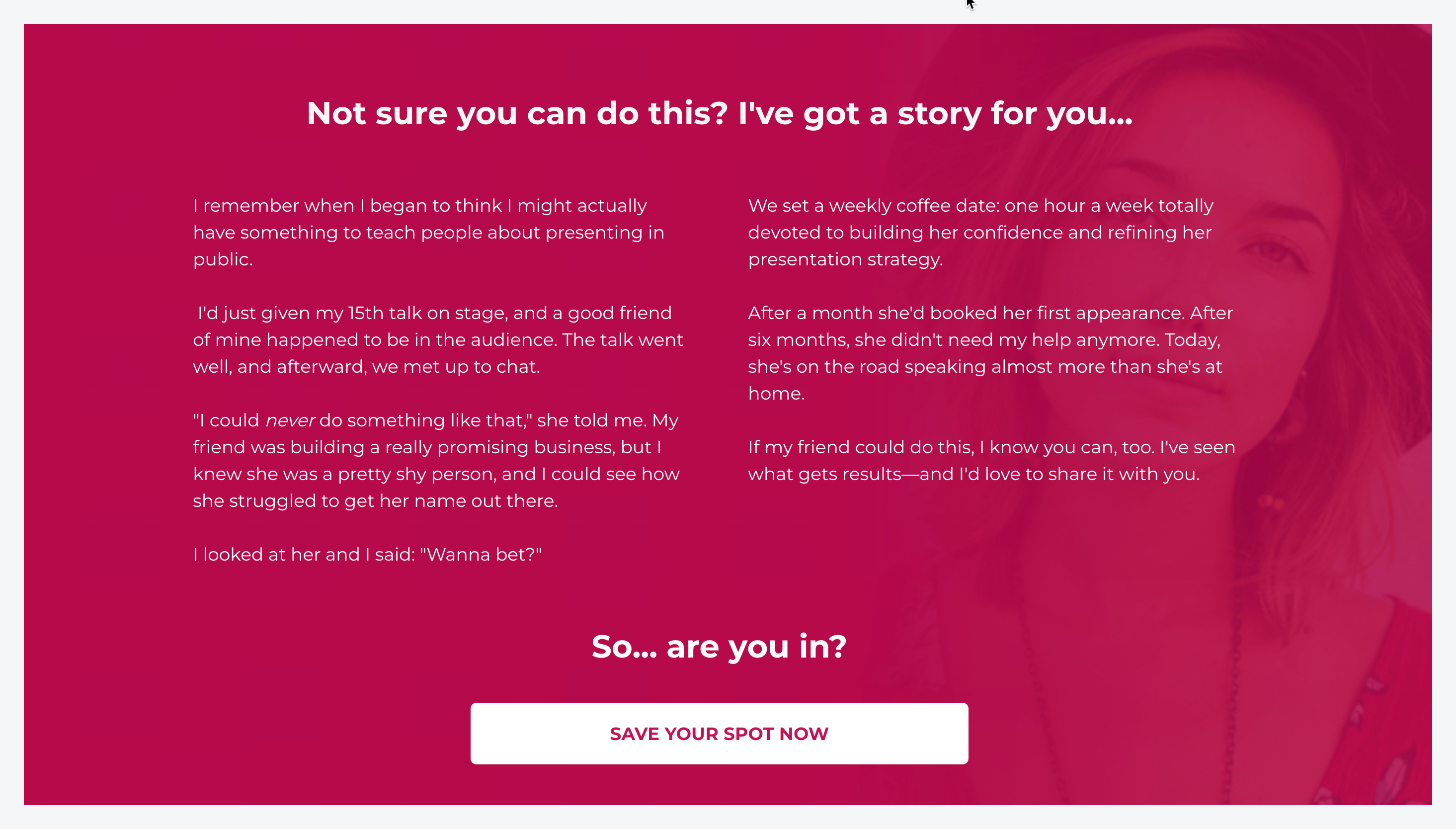 If you aren’t confident in your ability to write something like this, it may be better to stick with bullet points or a quick video. Sometimes less is more and you don’t want to accidentally talk someone out of signing up for your webinar by telling your story in a way that’s not succinct or sufficiently compelling.
If you aren’t confident in your ability to write something like this, it may be better to stick with bullet points or a quick video. Sometimes less is more and you don’t want to accidentally talk someone out of signing up for your webinar by telling your story in a way that’s not succinct or sufficiently compelling.
3. Can I trust what they’re teaching?
The third question you have to answer is if visitors can trust not just who you are, but what you’re teaching.
Another way to ask this is, “Do I know that I’m going to get value from my time spent?”
This is also where testimonials will be important as social proof. However, another way to demonstrate that people can trust what you teach is by how you describe what they will learn.
By using bullet points, for example, to lay out the structure of your training or curriculum, you can convey to people exactly what you will deliver. But showing you have broken down and organized your training in a specific way demonstrates that your approach is not haphazard. It is something you have thought about a lot and assembled into a framework that others can follow.
Here is an example of a section of a landing page that accomplishes this very well, because it specifically lists everything that will be covered in the webinar and shows the host has a certain level of mastery of the topic.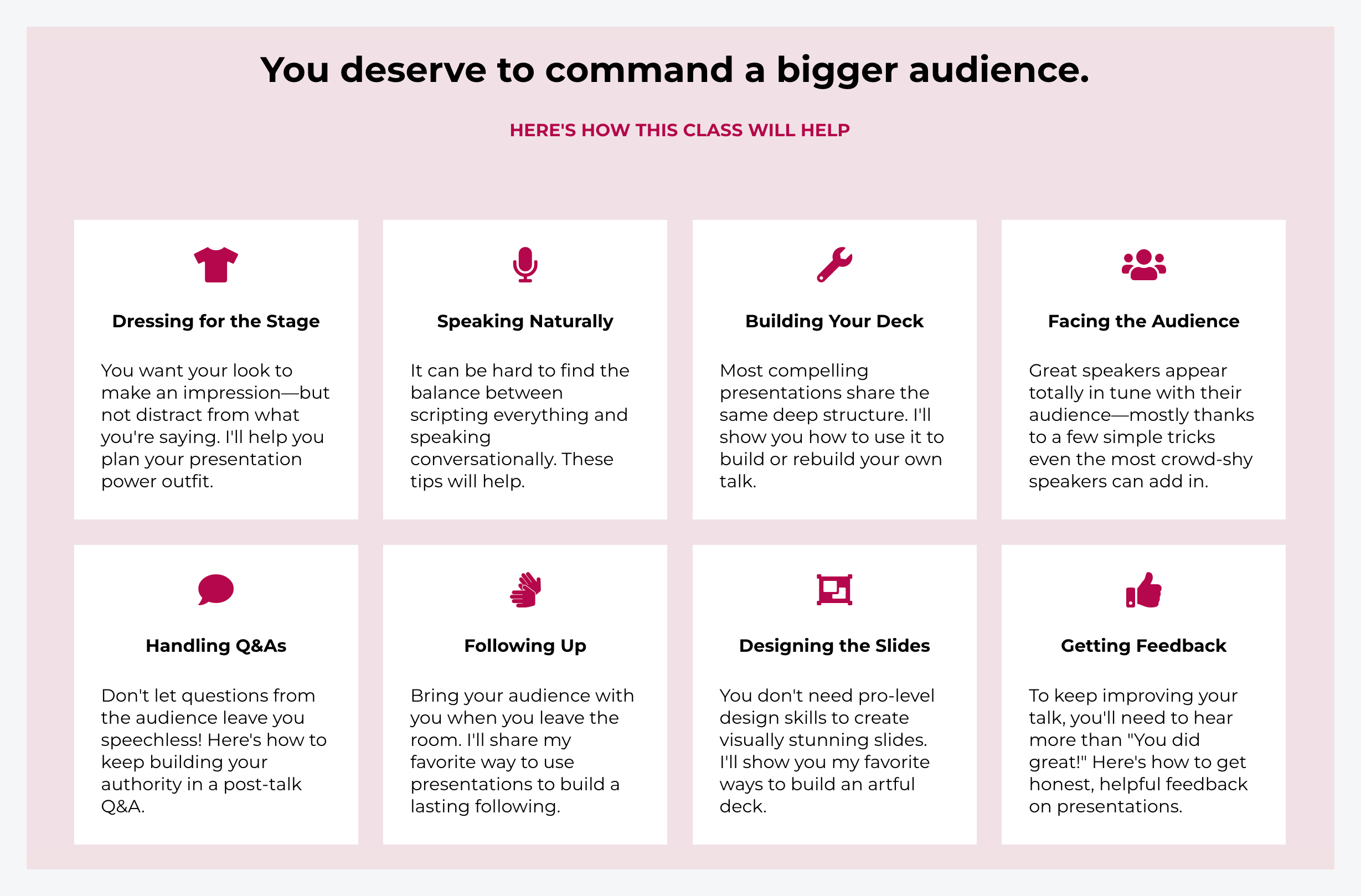
4. When can I watch?
This last question is purely logistical. Make it easy for a visitor to decide if they will be able to attend your webinar based on when it is.
In the case of evergreen webinars, since they are pre-recorded, you can offer visitors a few ways for when and how to watch your webinar. Because it’s impossible to know the circumstances of every visitor, it is better to provide options without overwhelming them with choices.
For example, with eWebinar, you can offer three different options to visitors when signing up for your webinar:
Just-in-time sessions
When you enable just-in-time sessions, there is always a session available for visitors to join within a few minutes of landing on your registration page. Thus, they are always “just in time” to watch your webinar.
By allowing visitors to join your webinar effectively on demand, you make it possible for them to watch your webinar at a peak moment of interest, when they are more likely to take action. A countdown clock creates urgency, encouraging them to join a session right then and there.
In the example below, you can see a clock counting down the time to the next session displayed inside a bar that stays fixed to the bottom of the page as you scroll.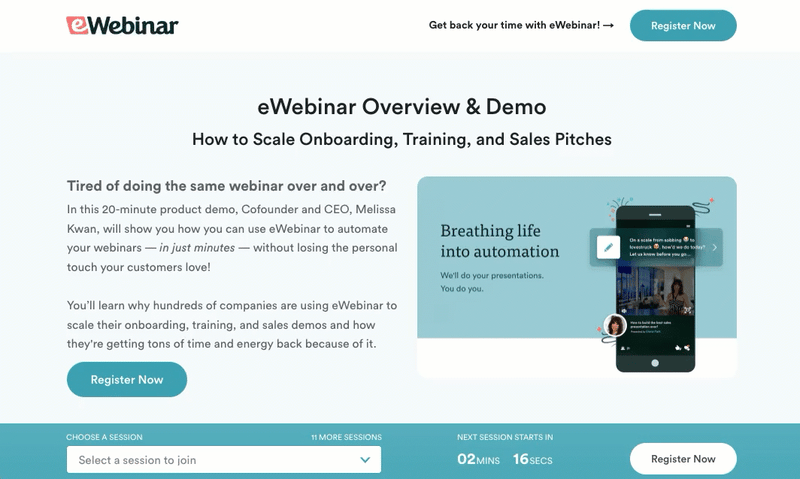 Alternatively, you can make sessions available on demand, so visitors can start your webinar with a click right after registering.
Alternatively, you can make sessions available on demand, so visitors can start your webinar with a click right after registering.
Convenient recurring schedule
Since not everyone will be able to attend your webinar right away, you can offer a handful of specific times in the coming few days for people to sign up for and put on their calendar. That way, you capture the registrant in that moment and eliminate the risk of them leaving without signing up. Plus, you can send them email reminders to ensure they show up for their session.
PRO TIP: With evergreen webinars, we recommend you say how long your webinar is so that people can decide if they have enough time to join a session starting right then or if they should choose something later that day or the next.
Webinar replays
Finally, some people will just want a link to watch a “replay” of your webinar at their convenience. Replays are especially attractive to frequent webinar goers since they can pause the video or watch at 2X speed.
The average attendance rate across all of eWebinar’s customers is 65%, which is 46% higher than the industry average for webinars. This is because our scheduling options let people join a webinar on their terms and at their convenience.
What to do about page length and CTAs
Two of the biggest concerns people have about their landing pages is whether or not it is the right length and if they have treated their CTA in the best way possible.
Page length guidelines
When it comes to how long or short your page should be, usually two sections are enough to address the emotional journey of the visitor and to answer the four questions listed above.
According to Leadpages’ data, shorter pages usually convert at a higher rate, like 50% to 60%. The tradeoff, however, is that sometimes your sales conversion rate may be lower because your leads were not properly qualified in terms of their likelihood to purchase.
Some sales-focused pages may need to be longer. The idea is that if someone spends time to read through your whole page and then signs up, their likelihood to immediately convert to a customer is higher.
But since longer pages tend to convert at a lower rate, in part because people feel like they have to read the whole thing before making a decision, you’ll need to choose what is more important to you: volume or lead quality.
We lean towards shorter pages. Because once you’ve captured the lead, you can nurture the relationship until the person is ready to make a purchase. But ultimately it’s up to you and the needs of your business.
Best practices for CTAs
People are often most concerned if they are following best practices in their CTAs, since that’s typically the whole reason the webinar even exists.
In terms of how many clickable CTAs to include on the page and where to place them, for shorter pages with only a couple of sections, two CTAs is usually enough, one at the top of the page and one at the bottom. For pages that are a bit longer, three is better since you will also need one in the middle. Be sure the color of your CTA stands out against the background so it is easy to see and that the text of each CTA on the page is identical (i.e. SIGN UP NOW).
People often suggest you include a short form at the top of the page of just name and email address, but Leadpages has found that pages with a sign-up form in the header section convert at a lower rate.
This is what they call a “taking” page. People’s guard goes up because it can seem like you just want to get their email address.
Leadpages suggests instead you create a “giving page”, where the focus of the top of your page is to offer information. You can still have a CTA, of course, but it should be something like a CTA button.
Embedding a simple registration form at the bottom of your page, however, shown in the example below, to make it easier for people to quickly choose a session and sign up, is often a good idea, since you have already had a chance to gain trust and build rapport. In the end, however, the only way to know for sure how well your CTA is working is to A/B test it against other versions.
Finally, look for ways to add urgency to your landing page to encourage people to join a session sooner rather than later. eWebinar, for example, automatically adds a timer next to your CTA if there is a session beginning within an hour.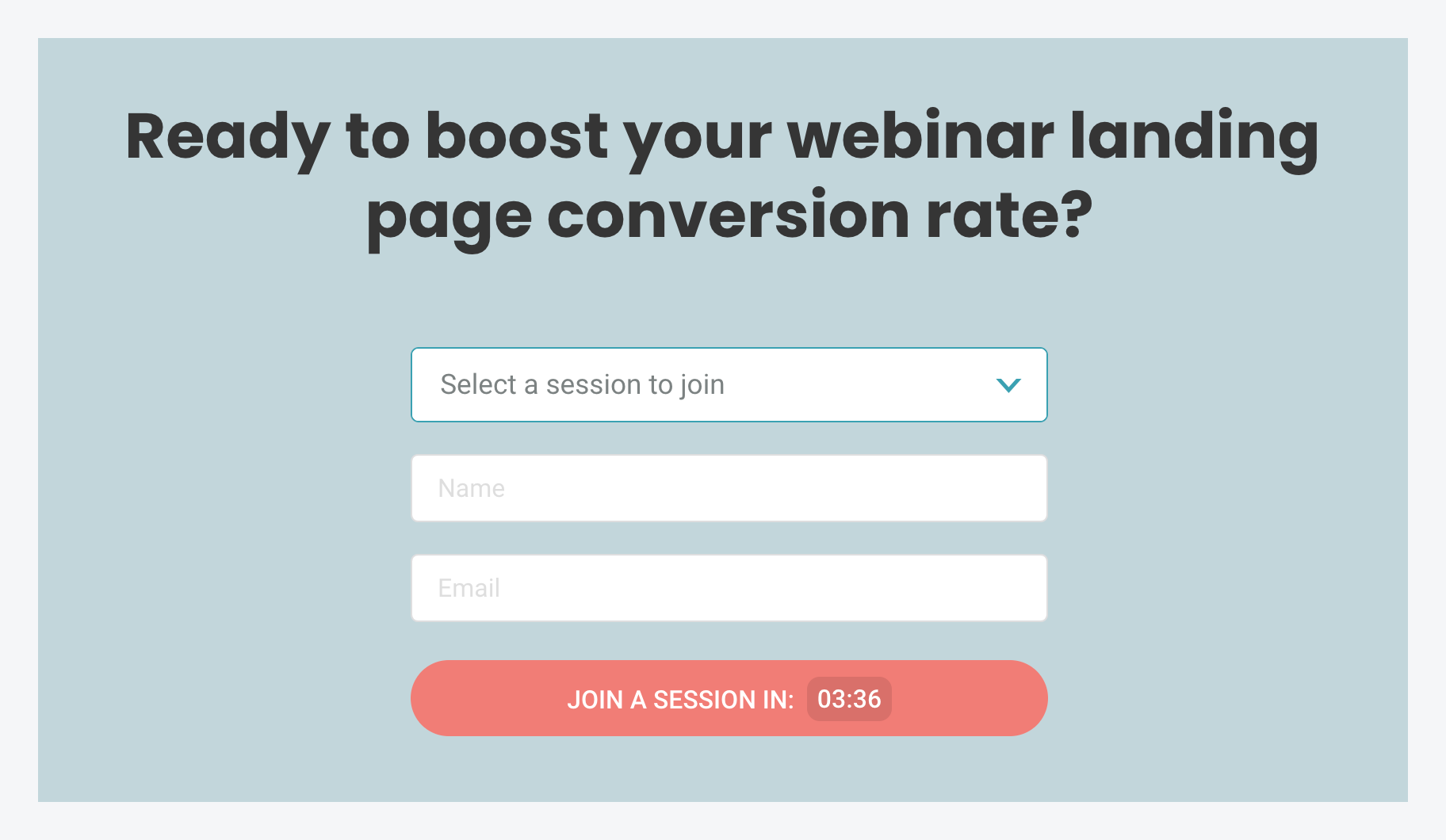 Another way to add urgency is to offer a bonus resource (like a checklist or template) to those who join the next upcoming session.
Another way to add urgency is to offer a bonus resource (like a checklist or template) to those who join the next upcoming session.
How to promote a webinar landing page
Once you have created your webinar landing page, you need to promote it. Here are a few great ways to do that:
Social media
Your best customers are somewhere on social media. If you haven’t already, begin to build your brand on relevant platforms. While LinkedIn and Twitter tend to have the best B2B audience, you can test other platforms as well.
The question most people ask is what they should post on social media to promote their webinar.
First, you can scan through some of your most common FAQs from potential customers and then ask those questions on social media. Provide your thoughts on that question and then invite others to engage by asking them if they have other opinions.
If it takes off, you can then let them know in the comments that you created a training covering the topic and link to the webinar landing page.
Another favorite hack is to take an interesting 30 to 45 second clip from the webinar and post it on social media. Then, include a CTA with a link to the webinar registration page.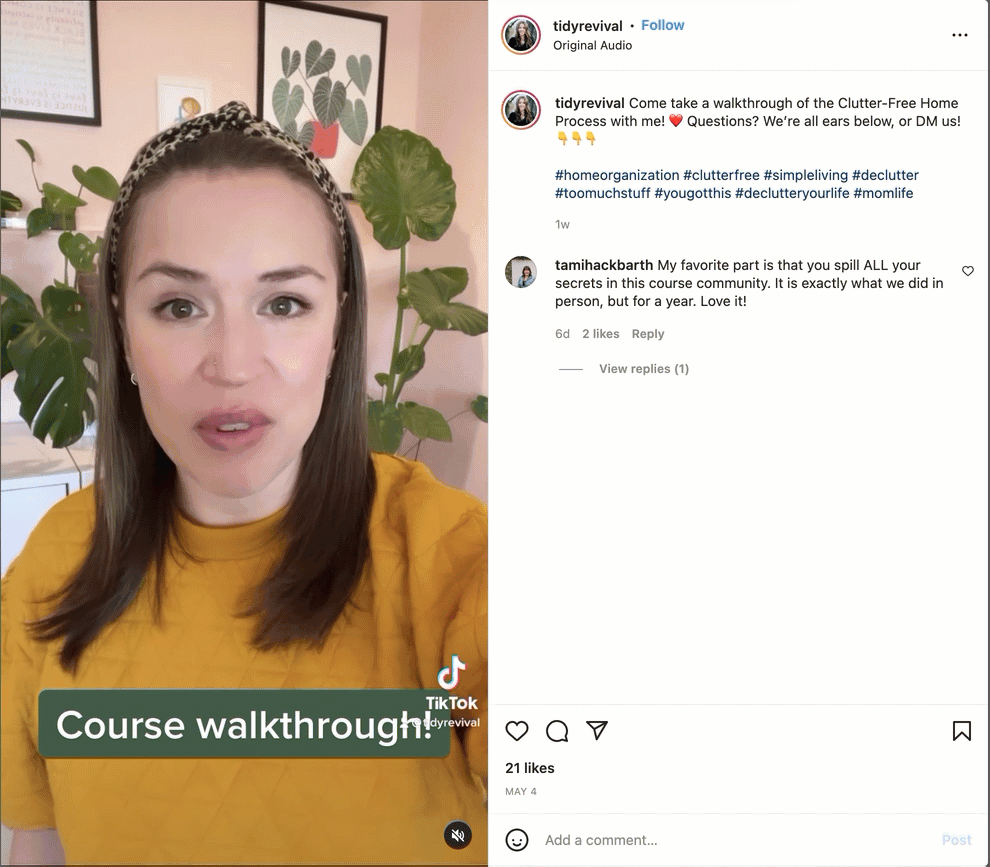
You can also always use paid ads to promote your webinar. However, we recommend that you optimize your webinar first before scaling conversions with ads.
Quora
Another strategy to generate traffic is to go onto Quora and search for questions related to your webinar topic. You can then provide a thoughtful answer to those questions and link to your webinar at the end if people want to know more.
SEO
While it may not make sense to optimize a landing page for SEO for a live webinar that may only be a one-time event, it’s well worth the effort to optimize your evergreen webinar landing page for search engines as it is a long-term piece of content.
Bob recommends that you first optimize the landing page for conversions and then go back and add in SEO optimizations. Otherwise, you might have to change the page for optimization purposes and have to ultimately redo all of the SEO work you’ve already done.
Here are a few specific SEO hacks that you can leverage:
- Add keywords to the titles
- Add relevant H tags
- Internally link to it from relevant pages
- Optimize any images with alt text and proper sizing
Attendee ambassadors
Another underrated marketing strategy is simply asking attendees that loved the webinar to share it with their networks.
You can do this by adding social media buttons on the thank you page and asking them to share it with anyone they think might enjoy it.
![]() Another effective method is to ask attendees in the webinar recording to share it with their networks. If you’re using eWebinar, you can even add an interaction into the webinar script asking people to share it.
Another effective method is to ask attendees in the webinar recording to share it with their networks. If you’re using eWebinar, you can even add an interaction into the webinar script asking people to share it.
Finally, invite people to share the webinar in your thank you emails to attendees. This way, they can just forward the email with all of the webinar details to their friends and colleagues.
Other lead magnets
You can also embed the webinar registration page into other lead magnets like checklists and templates. This is a particularly excellent way to promote your webinar as these people have already acknowledged that the webinar topic is a pain point they’re working to solve.
Email marketing
There are a few different ways you can promote your evergreen webinar through email marketing.
First, add a CTA and link to your webinar registration page to your email signature. This way, anyone that interacts with you will see the link.
You can also create a traditional email marketing campaign to your subscribers that teases the content in your training. One effective technique is to add the link to an email on day 45 or day 80 of your welcome nurture sequence. Not everyone will buy on the first interaction with your brand, but if you consistently remind them of what you offer, they will convert when the need arises.
To learn more ways to promote your webinar, check out this post we wrote on the topic:
4 common webinar landing page mistakes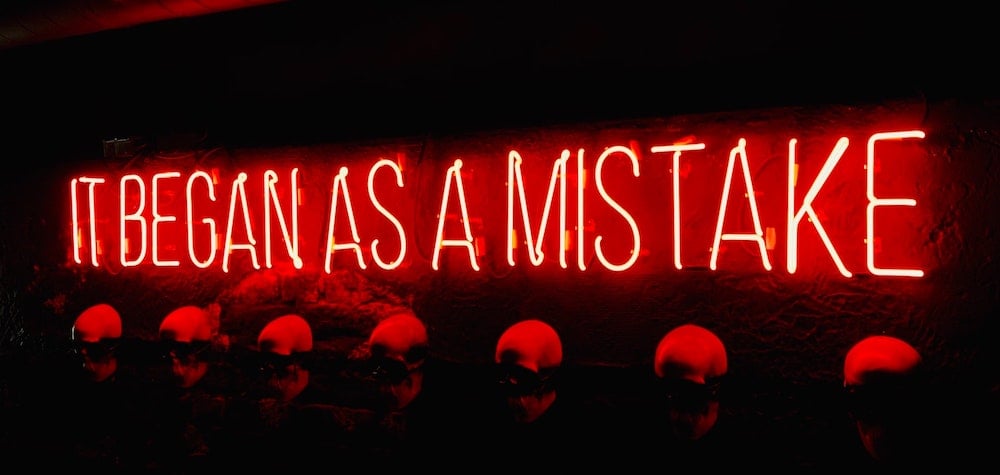
There are a few landing page mistakes that many people don’t even realize they make. Here are the four most common ones we see:
1. Trying to perfect your webinar landing page
Most people spend too much time perfecting their webinar landing page when they should really just get it out there and see how it performs.
This is especially true with evergreen webinars. Since they are ongoing, you can always tweak and split test your landing page later in order to optimize its effectiveness and conversion rate. You can’t make a page better without feedback anyway, so just get it out there.
2. Talking too much about yourself
While it’s important to introduce yourself to your audience, any content on your landing page that is about you should only serve the purpose of informing the reader why they can trust you to solve their problem.
For this reason, it’s best to avoid talking about yourself too much. Only share credentials, accolades, and awards, for example, if they are directly relevant to the problem you solve in your webinar. Instead, focus on the results that you’ve helped other people (just like your prospect!) achieve. Testimonials are a great way to indirectly talk about yourself.
3. “Setting and forgetting” your landing page
Treat the landing pages of your evergreen webinars like an ongoing marketing campaign that you must constantly test and improve. Even if you follow all of the instructions in this post, you’ll still have to make tweaks and adjustments over time based on what you learn.
Test different versions of your copy, images, CTAs, traffic channels and other variables. You can also take some of the FAQs asked over time during your webinar and incorporate them into future versions of your landing page.
4. Referencing specific times of day or year
The last awkward mistake that people often make is referencing a specific time of day, week, or year in the landing page of an evergreen webinar. Mentioning a holiday like New Year’s Eve, for example, or how cold it is, will make no sense to someone looking at your landing page in the middle of summer in July.
Frankly, this is a mistake people usually make in the evergreen webinar itself and not on the landing page. While we don’t think it ever necessary to hide that a webinar is pre-recorded, there is no need to unnecessarily jolt people out of the experience by mentioning a time of day or year that simply doesn’t make sense.
So whether it’s on the landing page or during your video, avoid using any language that references current events, times of day (Good morning!), seasons, holidays, and anything else like that.
Start with a webinar landing page template
Whether you are new to building webinar landing pages or have created too many to count, an easy way to implement the practices outlined in this post is to use one of Leadpages webinar landing page templates as a starting point, specifically the one that was created in partnership with eWebinar, which you can find here.
To learn how to connect eWebinar with Leadpages, watch this quick 90-second tutorial.
If you want to hear the entire conversation between Bob and Melissa that was the inspiration for this post, you may register for their webinar below:
And finally, if you are not already a Leadpages customer, start a free trial today.
We hope you now have everything you need to create a high-converting webinar landing page. Just remember it is a process. You will learn more as you go, especially as you test and track the effectiveness of everything you create.
Happy page building!
[ad_2]
Source link









